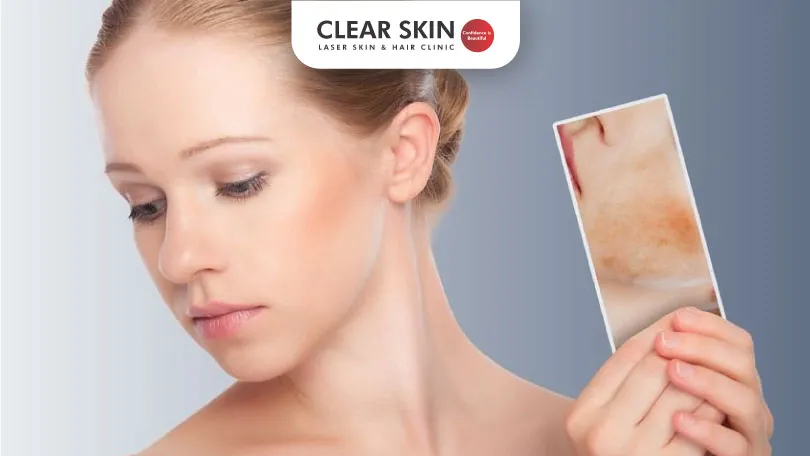Encountering The Distinctive Skin Pigmentation Problems
Reviewed By: ![]() Dr. Dhananjay Chavan
Dr. Dhananjay Chavan
Updated on: 05th April, 2024

Melanin is the brown pigment responsible for skin color, varying in composition from fair to darker skin tones. Produced by melanocytes in the epidermis, melanin can influence skin discoloration. This condition, which deviates the skin from its natural color, can cause the skin to appear lighter, darker, or reddened due to various factors, including cuts, scratches, or burns.
Table Of Content
- The Diverse Skin Pigmentation Complications
- Why am I Facing Pigmentation?
- What are The Causes?
- Treatment
- Visiting The Doctor
- Conclusion
The Diverse Skin Pigmentation Complications
Hypopigmentation:
Hypopigmentation is generally caused due to damage to skin, inflammatory conditions or hereditary conditions. This involves the decrease in the constituent melanin beneath the skin surface. This mostly occurs due to a decrease in melanin production.
- Generalized– pallor that is paleness of skin is observed in case of anemia. Generalized hypopigmentation usually occurs due to congenital or racial problems. Eg- albinism
- Localized– this is due to partial or complete loss of melanin in a given area. Eg- vitiligo, leprosy, lichen sclerosus, pityriasis alba, pityriasis versicolor, piebaldism, idiopathic or progressive macular hypomelanosis.
Vitiligo– It is an acquired autoimmune disorder in which white patches of skin are present on the body focally, symmetrically or universally.
Albinism– This is a birth defect in which there is a complete loss of pigmentation in skin, hair, and eyes.
Hyperpigmentation:
Here the skin is darker in color than usual due to deposition of increased amounts of melanin. The most common problems behind it are a side effect of drugs, over sun exposure and disorders causing inflammation.
- Generalized – it is seen in 95% people with Addison’s disease, 90% of people with hemochromatosis, rarely in metastatic melanoma and in people treated with afamelanotide.
- Localized– it can be due to melanin, hemosiderin or externally derived pigment.
Some examples are as followed-
- Naevi and lentigos
- Skin cancer such as melanoma, basal cell carcinoma.
- Pigmentation prior to injury, eczema etc
- Superficial skin infection
- Photocontact dermatitis
- A chronic pigmentary disorder like melasma
- Thickened skin, pigmented purpura.
Melasma– In this disease brown patches are seen, most commonly on the face. It also occurs in pregnancy but resolves after pregnancy and is called chloasma.
Depigmentation:
Complete loss of pigment. Eg- vitiligo. Onset is on life experiences, there is no sex predisposition, lesions are milky white, round or oval in shape and spread.
Some other skin pigmentation problems are acanthosis nigricans, xeroderma pigmentosum, incontinentia pigmenti, lentigines etc.
Red skin is seen in the case of pityriasis alba. It is scaly in nature and is believed to be a manifestation of atopic dermatitis.
Why am I Facing Pigmentation?
Pigmentation is the accumulation of dark pigments that is melanin beneath the skin which leads to dark facial spots. Melanin production is triggered by sun exposure, so take care everytime you go out on a bright sunny day.
What are The Causes?
- Melasma- it is prone in people with darker skin types and women undergoing pregnancy.
- Rosacea– red acne on the skin which is idiopathic in origin for now.
- Acne– caused due to overproduction of oil or sebum which combine with dead skin and bacteria to clog pores and cause lesions.
- Sun damage is also a major factor in the race to skin damage and can cause cancer.
Treatment
- Wood’s lamp examination is done to emit UV light in 365 nm range and assist in the diagnosis of various pigments and infectious disorders.
- Fungal and bacterial infections, lice and nits, vitiligo, erythrasma, porphyria cutanea tarda, and other pigmentary disorders can be diagnosed by it.
- The treatment for skin pigmentation usually prescribed by a physician include- microbiological culture and microscopy of affected skin and skin biopsy.
In hyperpigmentation treatment suggested are-
- Hydroquinone
- Topical Retinoid
- Topical steroid
- Glycolic, azelaic and ascorbic acid.
In hypopigmentation therapy, chemical peels, corticosteroids, surgery and removing remaining pigment works.
A chemical peel is used to exfoliate and peel the skin off so that new skin is generated at the site of a lesion. They are of three types – superficial, medium and deep peels. It should not be used in nursing or pregnant woman, psoriasis, eczema, dermatitis or rosacea, having taken Accutane in last 6 months or used retinoid in last 48 hours.
Dermabrasion is used to remove the upper layer of the skin. It is used to treat brown spots, skin scars, skin lesions, sun damaged skin, wrinkles etc.
Laser therapy is used to improve the appearance of skin. It is accompanied by effects like swelling, itching, burning sensation, scarring etc and should be thought of properly before administration.
Visiting The Doctor
- When injuries like burn surface you must visit the doctor for there is a strong potential for infection.
- In severe cases of acne, hypopigmentation and rosacea visiting the doctor is a must.
- Birthmarks do not need treatment but in case of an increase in size visit to the doctor is necessary.
On the positive front most of these problems are easy to treat and will only traumatize you temporarily but prevention is better than cure so visit a doctor in case of any discomfort.
Do You Know?
Roughly 250 Patients Are Treated
Everyday By These Dermatologists
(You are one click away from flawless skin)
Meet Our Dermatologist!
Conclusion
Skin pigmentation disorders encompass a wide spectrum of conditions, from hypo- to hyperpigmentation, each with its unique causes and treatments. Understanding the underlying factors, whether genetic, environmental, or related to health conditions, is crucial in devising effective treatment plans. From topical treatments to advanced procedures like chemical peels and laser therapy, modern dermatology offers a range of options to address these concerns.
Early consultation with a qualified dermatologist is key to managing pigmentation issues effectively, ensuring both cosmetic enhancement and overall skin health. With proper care and treatment, many individuals can achieve significant improvement and regain confidence in their skin’s appearance.
Further Reading
No Results After Laser Hair Removal?
Explore expert advice on laser hair removal, its effectiveness, and aftercare. With tips from dermatologists.
Can Laser Hair Removal Damage Your Tattoo?
Curious about laser hair removal with tattoos? Learn how it works, explore alternatives, and get safety tips.
Understanding Laser Hair Removal: A Dermatologist’s Insight
Experience safe and effective laser hair removal with expert tips from dermatologists at Clear Skin pune. Schedule your consultation today!
Salicylic Acid: Your Ultimate Guide to Banishing Acne Scars
Discover how Clear Skin Pune can help you say goodbye to acne scars using Salicylic Acid.
Have thoughts? Please let us know
We are committed not only to treating you, but also educating you.






